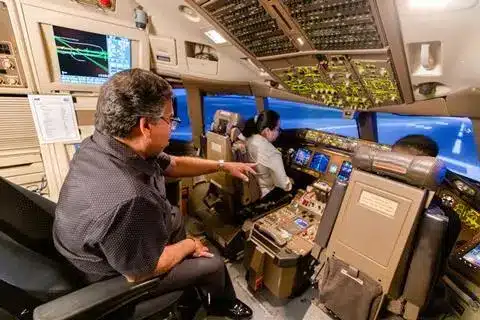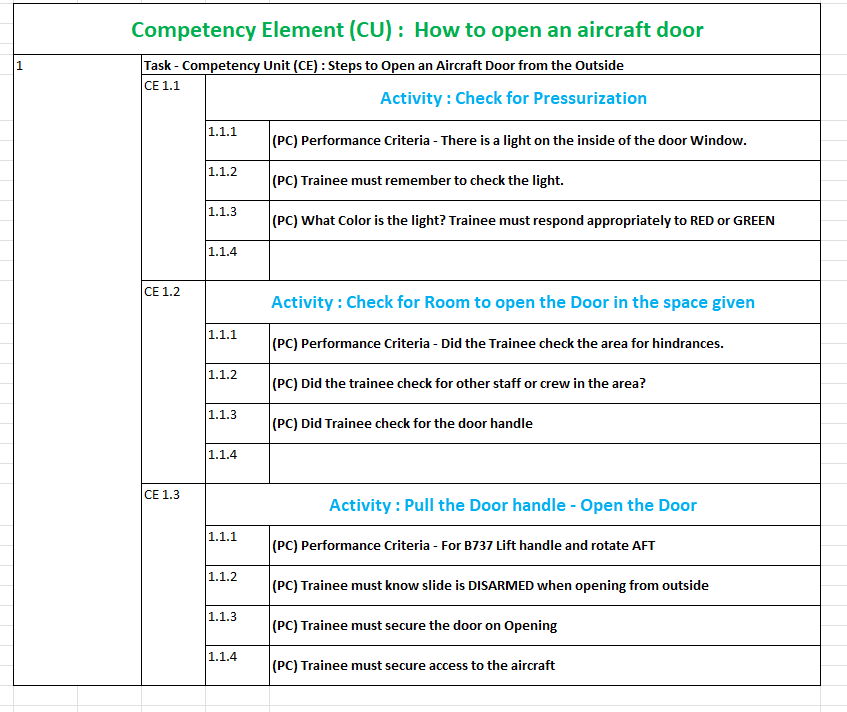Evidence Based Training Explained
The Future of Aviation Training : Why EBT Works
A quiet Revolution is happening in Aviation. In truth, its been happening for a number of years but recent updates to key areas of Pilot, Cabin Crew (CCA) and Dangerous Goods Training have brought Evidence Based Training (EBT) and Competency Based Training Assessment methods (CBTA) to the fore.
More Show Less Tell
CBTA and EBT are fundamentally the same – they focus on one simple rule. Can trainees show competence through action?. For example, if I want to teach a pilot how to execute a turn on a B737, or how to read the levels of a hand-held cabin fire extinguisher.
Or even how to catch a red flag on dangerous goods paperwork for a consignment of lithium batteries. In the past I would have delivered a lecture (or online explanation of HOW to do these things).
Today, I want so see you perform these tasks. And I want to grade you on how well I think you did.

Tell me and I forget. Teach me and I remember. Involve me and I learn.
Benjamin Franklin
While you sat there and read, or listened (or watched an e-learning module) you took in around 20% of that information. If I had made you reenact any of those scenarios under assessment, you probably would never forget.
Hopefully most of you will recognize the difference. But there’s one key element that we need to drive home. When we say MORE SHOW, we don’t mean the instructor. We mean the TRAINEE. We need the trainee to show us they have understood the instruction – by executing the task to a pred-determined level.
And we as instructors, must ensure we have given them every instruction, tool or practice so they have the best possible chance to succeed.
Simple to understand, but devilishly tricky when you are the one designing the training syllabus. So stick around and we will tell you how to accomplish this feat.

pilotinstitute
Are You Ready To Take Off?
Pass the FAA Private Pilot test with flying colors. Achieve your dreams of flying an airplane.
CBTA - How to Show, Not Tell
Evidence Based Training (and CBTA) was born from the ICAO PAN-TRG (Doc 9868) assessment changes. The FAA also have the Advanced Qualification program (AQP). In the past, pilots would study remotely or listen to lectures. They would then move to flight training at a later stage. It was only then that instructors would be faced with trying to correct errors in task execution born of theoretical understanding.
Beyond Lecture Based Training
Chances are you’re not a pilot. But you are a trainee. You may even be an instructor who understands that outcomes and competencies can be ethereal and not task-based. Tasks like an aircraft maneuver or hitting a switch to shut down fuel supply to a engine.
Maybe you need to deliver a module on Empathy? Or fatigue? So now what do you do?
Evidence Based Training - Practical Example
We want to keep this simple – because it is. And what we want to do is be a starting runway in your journey into CBTA and delivering evidence-based training. So what are the first steps? What are the best evidence based strategies? How can you start your engines?
First get a qualified Instructor. Ask them to implement CBTA in their curriculum design by using a Competency Framework. The key elements of a competency framework as defined by ICAO are as follows;
CU – Competency Unit
CE – Competency Element
PC – Performance Criteria
Note : Each Competency Unit (CU) should be composed of different Competency Elements (CE) depending on the task and is complexity.
Below is a practical example to better show these elements.
In this case, its a (simplified) process of opening an aircraft door from the outside.
Understanding Evidence Based Training (EBT)

Why Evidence Based Training Matters in Aviation?
Hopefully you had a Eureka moment. If not then don’t worry, most of aviation yet to get grips on how to implement CBTA.
The trainee should experience the “learn by doing” method, which involves teaching both knowledge and skill. It ensures that assessments are closely related to the work function. In this case the course is directly aligned with how we expect the trainee to open the aircraft door.
Your company and instructors can more accurately select the training and assessment (material and technique) that best meets their competency needs. If they used this approach. Thanks to the framework tools (Units and Performance criteria) better decisions on how to use the tools are applied.
Employers who are more aware of learner needs can assist course designers produce more specific and scenario-based curricula.
Digital Elephant in the Room
There’s another reason to employ evidence based training and CBTA.
ChatGPT.
Especially if you’re using eLearning or remote digital training programs without invigilation. If inclined, a trainee could have Chat GPT open during assessments.
ChatGPT4.0 can now read screens, saving the lazy trainee the hassle of even asking ChatGPT to read a multiple-choice question. It could potentially just read the MCQs on the screen and tell you which option is correct. Once your Aviation Authority figures this out, you’ll be forced to through these modules in the trash.

TRAKRACER
Hone your aviation skills with these great flight simulator products from TrakRacer.
Get yourself in the sky today and feel what it’s like to be a pilot!
Competency Decay
Covid 19 taught us many lessons. A big one was the currency and availability of qualified staff in all aviation sectors. And while we sat around for two years, diminished skills and an aging workforce made restarting a nightmare. CBTA offers us hope in the form of scenario based recurrent training. Regular practice and exercises on real-world tasks make training so much more engaging and enjoyable.
Rather than looking at bullet points on a screen and expecting people to act correctly when the time comes.
Evidence Based Training Practices - CBTA
Going through this process has a lot of benefits. So if you’re thinking – holy moly that’s a lot of work. It is. But there’s only small changes in the syllabus creation process. If you’re working on digital-learning and having trouble deciding what content and scenarios you should use. The CU, CE and PC method is best way to brainstorm your training into MODULES prior to creation. This is why the instructor role is so important.
What might be the Impact on Training Content?
- Creating modules which can (and should) be continuously modified. These modules can be modified to meet recurrent training goals.
- New technology (VR, Gamification) can be introduced around these units to further engage the learner.
- You create a MINIMUM-CONTENT benchmark for training. Other instructors will “get it” and starts to conceptualize their own material to meet this outcome-based approach.
Scenario Based Training
- CBTA will create many different approaches to training and assessment and will ensure your instructors make better choices on tools. Your trainees will no get a real understanding of how their training and jobs connect.
- You will create Learning with ASSESSMENT in mind. Not just content into bullet points.
- Cost Implication – Yes, you will find the process more lengthy (i.e. expensive) and there could be costs associated with course sophistication.
Evidence based Training - For Instructors
Instructors are great. They do the most important jobs in aviation. But they are poorly supported. We need to upgrade them to ASSESORS. In line with checking the competency of trainees actions – not just delivering PowerPoint presentations. There should be better trainer training and they should be trained by employers to help their trainees master skills. They should be better informed to pick and choose the tools (technology) to both deliver and examine the performance criteria.
TNA or Training Needs Analysis is also a dying skill that needs to be brought back to life. Most Trainers just take what content is available and delivers in stoically to the masses. They need to do more. They need to know who needs which training and skills – based on their role in the organization.
Data-Driven Learning
And think of the data! Big data in aviation training is the analysis and discovery of insights from complex data sets. Why? for the purpose of enhancing training programs in your organization. Massive volumes of data, including skills data, maintenance tasks, crew reports, and even trainers comments would be collected every day as a result of technological advancements in training.
Aviation training programs can gather useful information from trainees to improve safety, efficiency, and effectiveness if you started with CBTA.

The Benefits of Evidence-Based Training Methods
Enhanced Safety
Think about it. If you’re training is composed of performance based scenarios you can continuously add to these and build a portfolio over time. You can take real incidents and recreate them for future reference.
Efficiency and Cost Savings
Right now every NAA (National Aviation Authority) wants you to focus on risk-based assessments across the board. They don’t want you reiterating EU or FAA laws on manuals when you have an issue on the floor that’s causing damage or harm. This is why risk-assessment is critical for your training. If you create training based on a TNA which is also based on risk analysis, this is what your authorities want you to do.
Competency Maintenance
People come and go. Staff turnover is a fact of life and the shift routine of aviation doesn’t suit everyone and can lead to a high percentage of changes over time. So how do you keep a high level of competency across your staff? By focusing on the skills transference and not the theoretical elements.
Good Program Design
Our advice here is to look at ICAO CBTA. They have everything you need online to learn about how this training is done. ICAO and IATA also have CBTA training courses which we highly recommend. They are not cheap, but if you dedicate 2-3 instructors for a year on getting your training to that level, it will be worth it.

pilotinstitute
Are You Ready To Take Off?
Pass the FAA Private Pilot test with flying colors. Achieve your dreams of flying an airplane.
Feedback
One HUGE benefit of CBTA is that is has in-built feedback through performance criteria. If a proportion of staff members are not able to do something, or cannot perform or fail to “get-it” then your training or instructor has a problem. Good. This happens, and EBT has played a part in bringing this issue to light, so that you can deal with it. Focus especially on critical events or potentially dangerous situations that take priority.
Staff mental Health
This is the biggest benefit for CBTA. Think about it. Training is about delivering skills to employees so that their life (and yours) is easier, better and more rewarding. By taking the time to focus on staff training (especially in the soft skills areas such as problem solving, empathy and critical thinking) they will respect and reward your efforts.
Using outside, 3rd party organizations, for this is both lazy and smells of box-ticking – unless they are scenario-specific and designed with your specific curricula in mind and over a long period.
CBTA Job Training Challenges
Ok now the bad news. CBTA and EBT – like a lot of things in life – is pain now and pleasure later. And there is no software or AI that can help you, regardless of the number of AI, Adaptive Learning, VR sales pitches you are getting. But hopefully you believe in investing in your staff;
- Train the Trainers – You need to first get your Trainer/Assessors trained in CBTA and EBT. They in turn can then advise the department leaders how to turn their content into scenario-based learning CU and CE’s.
- Time – This takes time. It requires mental work between teams to sit down and figure out the elements and what tools, platforms or technology best addresses them. For example with our aircraft door opening scenario, yes the actual door is best – but a virtual door that presents problems to the trainee could be equally effective training.
Evidence Based Practices
- Regulators – When you focus on Risk-based efficiency you need to make sure your aviation authority has your back. So start small. Take a small corner of your training programme and turn it into CBTA or EBT and see how it works. Your KPI and performance indicators will tell their own story. As will your experience.
- Criteria – How to score when something is done or not done can be a challenge. When you identify gaps in competency then you must react. New training elements or further training for individuals is now needed. And added to your training needs analysis.
- Fragmentation – When you create training based on competencies it can mean bringing staff from various supply chains into different modules. We think this is a good thing, but could complicate training management systems.
Best Aviation Training Organizations
Wingtalkers TIPS on CBTA Implementation
You will need to get buy-in. From everyone. Especially staff at the ground level and board level at the top. “What’s in it for me?” is a worn out phrase, but its worn out for a reason. If staff see a value for themselves in the training – you won’t need to do anything else. If there are personal skills embedded in the staff training programs, this alone can add value to the individual. They will recognize that;
- Start Small. Have something short but contained. With a beginning, middle and end. Have 2-3 scenario- based training elements in this 30 minute module. See how they work.
- Have a plan. Use LEAN to schedule training events (called Kaizen) that include all stakeholders. You would be surprised how many people can add value in course creation.
- Expect a 2-4 year journey – from introduction to mastery.
- Old-school Trainers – need to buy-in the most. Focus on them by adding value to their journey. Advanced Qualification Programs are provided by the FAA and EASA and a lot of them are funded by governments.
- What’s important in our industry? – Sustainability and Cybersecurity being a couple of examples. This is what your your people are thinking about and concerned with. If you start with these subjects you are far more likely to get that staff engagement.
